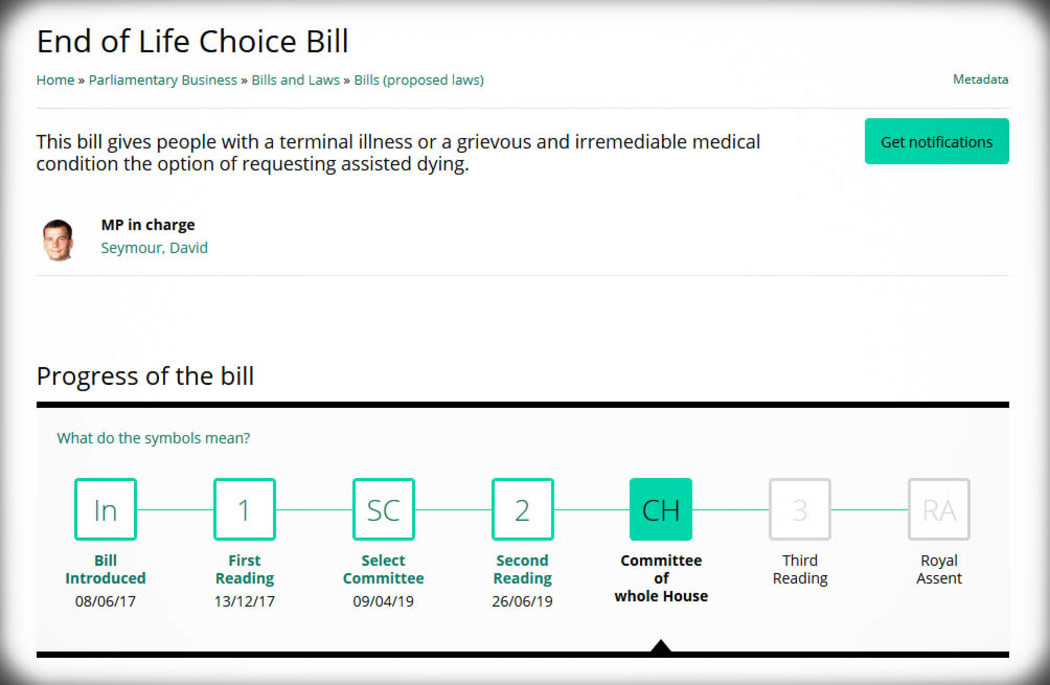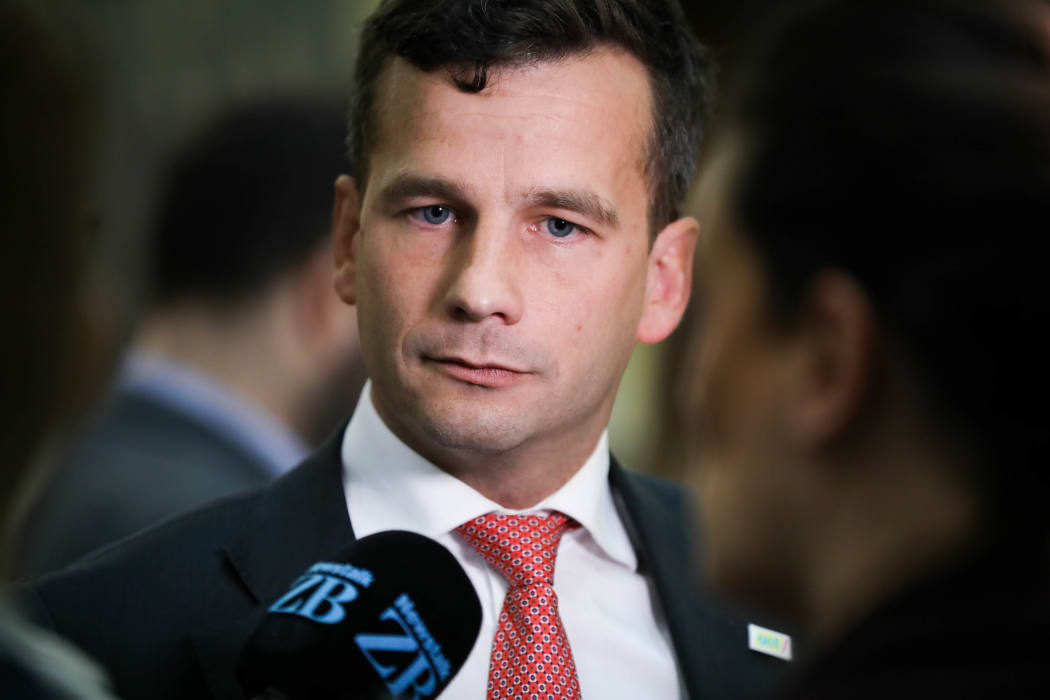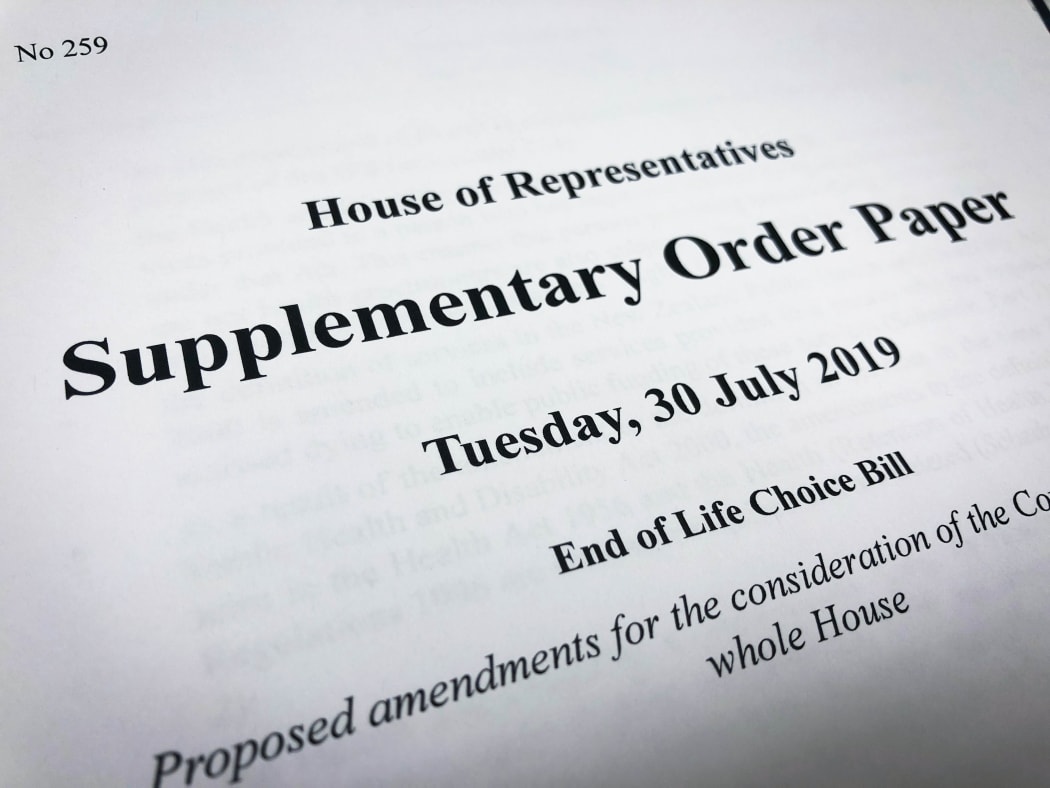Today’s tussle is called the Committee Stage. This stage has no vote to pass or reject the bill. So it cannot fail, it can only change in detail.
Bills get considered in the House four times before they become law. But each debate has a separate purpose. A first reading debate is over whether the very idea of a bill is worth considering. A second reading debate is over the public feedback heard by a select committee and suggestions for changes that arise from it.
This bill has now passed all that and is onto the Committee Stage.

A screenshop of the End of Life Choice Bills progress which is tracked on Parliament's website. Photo: NZ Parliament
The foundation is already set
By the time a bill gets to this third stage - the committee stage - parliament has already agreed the broad parameters of the proposed legislation - and those are now set.
The Speaker has even outlined what the agreed principles are:
- Some form of assisted dying will be available to New Zealanders
- Qualified medical personnel will be involved in assisted dying
- The assisted dying system will be state-controlled
- Instances of assisted dying will be recorded and reported on
So now they’re arguing over and adjusting the details within that. And this is their last chance to change things.
In theory MPs are now trying to make sure the bill does what they’ve already agreed it should do. Although MPs opposed to it will also be trying to restrict its remit, to make it less workable, or to try to cost it support among MPs.

ACT Party leader David Seymour speaks to media ahead of the committee stage for his End of Life Choice bill. Photo: VNP / Daniela Maoate-Cox
Arguing the details
This bill is written in four sections called Parts, so the discussion of proposed amendments will happen part by part. All the amendments related to that part will be debated together and then voted on one at a time. Before the whole part is agreed
A vote that 'a part should stand part' is a vote that it should remain in the bill.
The debate is not time-limited. MPs are allowed multiple five minute speeches so long as they don’t get repetitive or irrelevant. Whether they are is the Chair's call. The chair is occupied by the Deputy and Assistant Speakers. They keep a running tally of speeches and topics to help them judge.
MPs can keep suggesting amendments - also called supplementary order papers or SOPs - while the discussion goes on - right up until the House decides it’s talked enough and it will begin voting on the current part of the bill.
The proposed amendments are listed here. They're an interesting read. The biggest SOP is from the Bill's sponsor David Seymour who has proposed a new version of the Bill that seeks to ameliorate various MP's concerns and make changes that would often have been suggested by the Select Committee.

David Seymour's list of proposed changes for his End of Life Choice Bill. Photo: VNP / Daniela Maoate-Cox
MPs may ask for that voting to happen multiple times before the Chair relents and agrees. They’ll request it by asking that “the question be now put”. Yes, sometimes Parliamentary language is like something Long John Silver would say in Treasure Island. ‘Putting the question’ is Parliament speak for taking a vote.
Voting on a conscience issue like this one involves counting every MP as they file out so it will be slow going. And there’ll be lots of votes. So it'll be a bit like watching American Football with lots of breaks in play.
But you might be interested to watch who votes which way on which measure - because some of the voting might be quite tactical, which can make for odd bed-fellows.
There’s no Speaker for this stage and the action is controlled from the Table where the Clerk, the Chair and David Seymour (as the MPs whose bill this is) will all be shoulder to shoulder.
The Speaker will be watching as well though because it’s possible that an MP will get combative and request that he be 'recalled' to settle an argument. This is usually done to filibuster (waste time and therefore delay progress).
The reason David Seymour will be at the Table with the chairperson is so he can be asked and can answer questions from MPs. He can make as many speeches as he likes.
While it begins tonight, this stage could take a few weeks, because member’s bill’s are only debated one day a fortnight.
When the committee stage does end, the bill will be debated for a third and final reading - At that point it can no longer be amended and the vote is all or nothing. pass or fail. Live or die - so to speak.


